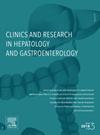一系列儿童炎症性肠病患者从静脉注射切换到皮下英夫利昔单抗维持治疗。
IF 2.4
4区 医学
Q2 GASTROENTEROLOGY & HEPATOLOGY
Clinics and research in hepatology and gastroenterology
Pub Date : 2025-09-01
DOI:10.1016/j.clinre.2025.102680
引用次数: 0
摘要
目的:英夫利昔单抗被批准用于儿童克罗恩病(CD)和溃疡性结肠炎(UC),但在儿童静脉给药方面受到限制。我们评估了儿科CD/UC患者从静脉注射到皮下注射英夫利昔单抗的有效性和安全性。方法:多中心回顾性队列研究,于2022年1月至12月在两个儿科中心进行,纳入临床缓解且体重≥50kg的CD/UC患者,接受维持剂量IV IFX治疗。主要终点:转换后6个月的临床缓解维持;pcdai结果:21例患者包括:11例(52.3%)女性,中位年龄17岁(范围:13-18岁),18例(85.7%)CD, 3例(14.3%)UC。诊断时的中位(范围)年龄为12岁(5-15岁);在纳入(M0; switch)时为16(10-18)年。所有患者均接受优化的IFX方案(每8周或4周10mg/kg)。所有患者在M0时临床缓解,并在6个月的随访中保持缓解。没有人停止治疗。血清中位(范围)IFX谷水平在M0时为11.3μg/mL (4.7-39μg/mL, n=13), M3时为17.8μg/mL (8.5-20μg/mL, n=10), M6时为20μg/mL (17.1-20μg/mL, n=6)。无患者发生AIAs。无严重不良事件发生;1例患者(4.7%)出现轻度注射部位反应。结论:对于儿童IBD患者,从静脉注射转向SC IFX似乎是有效和安全的。需要对儿童进行药代动力学研究本文章由计算机程序翻译,如有差异,请以英文原文为准。
A series of pediatric patients with inflammatory bowel disease switching from intravenous to subcutaneous infliximab maintenance therapy
Objective
Infliximab is approved for pediatric Crohn's disease (CD) and ulcerative colitis (UC), but is limited in children by its intravenous administration. We evaluated the effectiveness and safety of switching from intravenous to subcutaneous infliximab in pediatric patients with CD/UC.
Methods
Multicenter retrospective cohort study, from January to December 2022 in two pediatric centers, that included CD/UC patients in clinical remission and weighing ≥50 kg, treated with maintenance dose IV IFX. Primary endpoint: maintenance of clinical remission at six-months post-switch; PCDAI<10 for CD, PUCAI<10 for UC. Secondary endpoints included: IFX trough levels, anti-infliximab antibodies (AIAs), adverse events, and treatment persistence.
Results
Twenty-one patients were included: 11 (52.3 %) female, median 17 years of age (range: 13–18 years), 18 (85.7 %) CD and 3 (14.3 %) UC. The median (range) age at diagnosis was 12 (5–15) years; at inclusion (M0; switch) it was 16 (10–18) years. All received optimized IFX regimens (10mg/kg every 8 or 4 weeks). All were in clinical remission at M0 and maintained remission throughout the 6-month follow-up. None discontinued treatment. Median (range) serum IFX trough levels was 11.3μg/mL (4.7–39μg/mL; n = 13) at M0, 17.8μg/mL (8.5–20μg/mL; n = 10) at M3, and 20μg/mL (17.1–20μg/mL; n = 6) at M6. No patient developed AIAs. There was no serious adverse event; one patient (4.7 %) experienced a mild injection site reaction.
Conclusion
Switching from IV to SC IFX appears effective and safe in pediatric IBD patients. Pharmacokinetic studies are required for children <50 kg in order to determine the dosage of SC IFX that allows therapeutic trough values to be achieved.
求助全文
通过发布文献求助,成功后即可免费获取论文全文。
去求助
来源期刊

Clinics and research in hepatology and gastroenterology
GASTROENTEROLOGY & HEPATOLOGY-
CiteScore
4.30
自引率
3.70%
发文量
198
审稿时长
42 days
期刊介绍:
Clinics and Research in Hepatology and Gastroenterology publishes high-quality original research papers in the field of hepatology and gastroenterology. The editors put the accent on rapid communication of new research and clinical developments and so called "hot topic" issues. Following a clear Editorial line, besides original articles and case reports, each issue features editorials, commentaries and reviews. The journal encourages research and discussion between all those involved in the specialty on an international level. All articles are peer reviewed by international experts, the articles in press are online and indexed in the international databases (Current Contents, Pubmed, Scopus, Science Direct).
Clinics and Research in Hepatology and Gastroenterology is a subscription journal (with optional open access), which allows you to publish your research without any cost to you (unless you proactively chose the open access option). Your article will be available to all researchers around the globe whose institution has a subscription to the journal.
 求助内容:
求助内容: 应助结果提醒方式:
应助结果提醒方式:


